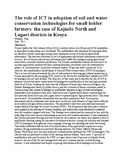| dc.description.abstract | Kenya typifies the Sub-Saharan Africa (SSA) countries where over 80 percent of the population is dependent on agriculture as a livelihood. The smallholders who dominate Kenyan agriculture are faced by various challenges among them inadequate access to technical agricultural information. This has been attributed to lack of appropriate agricultural information systems and services, lack of timely and relevant information and ineffective linkages among agricultural researchers, extension workers and farmers.
The Kenyan smallholders should not only strive to increase agricultural productivity from existing farmland, but further meet the sustainability pillars, i.e. environmental, social and economic aspects. If soil and water erosion are to be reduced, then smallholders should adopt to Soil and Water Conservation (SWC) technologies. There is renewed interest towards the role of information in fostering agricultural production in Kenya, prompted by the emerging ICTs; however the factors for smallholders' adoption to SWC technologies are not well defined.
The objective of this study was to identify the role of ICT in adoption of soil and water conservation technologies by smallholders in low and high potential districts of Kenya. Guiding the study was the Diffusion of Innovation theory by Rodgers, the Holistic Management theory by Allan Savory, and the evolution of farmer extension model in Kenya among other research findings on smallholder adoption to agricultural technologies.
Quantitative and qualitative data were collected across Kajiado North district representing the low potential areas of Kenya, and Lugari district representing the high potential areas. This study interviewed 120 smallholder households who provided quantitative data. Focus group discussions and key informant interviews were carried out with Ministry of Agriculture officials, local leaders and agricultural researchers. The quantitative data were processed and analyzed using Statistical Package for Social Scientists (SPSS).
The frequencies and descriptive statistics were applied in the analysis of various variables, and related data cross tabulated to establish how the variables changed with time. The findings were studied and documented in line with the study objectives and various relationships across selected variables discussed. It was established that women dominate farming activities across the two systems; the males were passive actors in smallholder farming opting for alternative livelihood activities. Among the common and adopted SWC technologies were gabions, strip cropping, terracing, tree planting and water harvesting.
This study established that the lack of technical advice from agricultural experts as a major problem facing smallholders across both farming systems. The Radio, Mobile Phones and Farmer Field Days were the most preferred communication platforms for SWC technologies. The Internet was not preferred in either of the farming systems studied. There were 72 percent of smallholders who used livestock for SWC in Lugari district and 10 percent in Kajiado North; however the use of fire for soil management was not a common practice in both farming systems.
It was established that despite acquiring information and technologies on fertilizer conservation, the smallholders were not practicing these due to lack of follow up and adequate training. The fallowing of land was a common practice, with 65 percent of smallholders practicing this method or scientific purposes. This study recommends the need for specialized training and re-packaging of technical information on SWC to women.
The smallholder women further require property rights and collective action for scaling up adoption to SWC technologies. This study established factors for smallholder adoption to SWC technologies as: communication language, labour intensity and profit margins. It is recommended that further research be undertaken towards the establishment of a Kenyan Fee-for service extension model, which besides communicating appropriate agricultural information and technologies will generate additional revenue for public extension programmes. | en_US |

